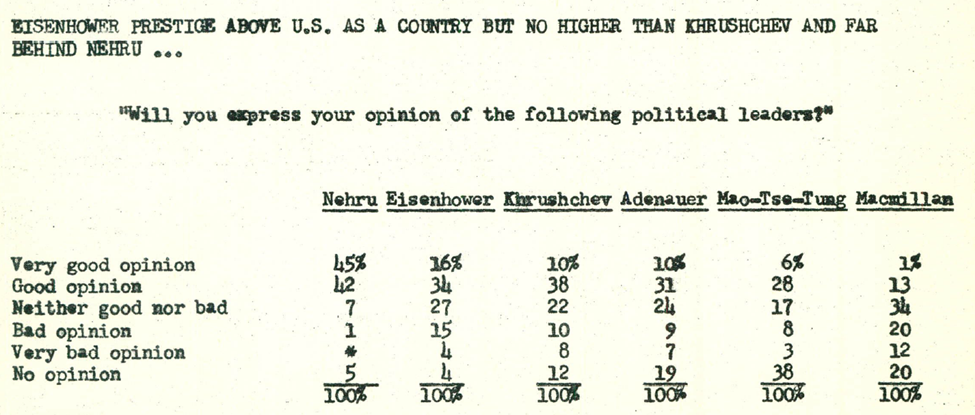This guide provides a short overview of some of the most valuable and interesting youth surveys in Roper Center holdings. Click here to go directly to the complete list of youth surveys in the archive.
Survey Series

The earliest youth survey began in 1938, the brainchild of Joe Belden, future founder of the Texas Poll, when he himself was a college student. His organization, Student Opinion Surveys of America, not only delivered frequent results from polls of college students, it also provided training for participating school newspapers in the newly emerging methodologies of survey sampling. While the data and most of the toplines from this project were never preserved, Roper Center offers a digitized collection of survey reports and other supporting materials. Access the Student Opinion Surveys collection.
The Purdue Opinion Panel [LINK] was an ambitious series that covered three decades. Purdue University Professor of Education and Psychology and Director of the Division of Educational Reference Hermann Henry Remmers built a large panel of participating high schools and selected his random sample from this respondent pool. Samples usually included between 2000-3000 students. Standard demographics for these surveys include sex, grade, religion, and mother’s educational attainment, while many also include party identification, community size, and questions about household resources that provide indicators of probable class/income. Topics include a full spectrum of political, economic, social, familial and educational issues. Learn more about the history and methodology of the Purdue Opinion Panel. [LINK]
The Trendex/General Electric survey series is valuable for researchers interested in many special populations. Over the duration of the series, which ran from the late sixties into the eighties, GE regularly interviewed not only the general U.S. public, but at different times, additional samples of Black Americans, professionals and managers, and college students. The 58 GE college student samples range in size from roughly 500 to 1000. Questions cover attitudes about race, local and national problems, energy and the environment, desire for greater or less government activity in various areas, personal career priorities, and other issues.

The United States Information Agency (USIA) public opinion program was dedicated to understanding views of the US around the world. College students were considered to be the likely future leaders of their countries, and as such, their attitudes were of particular interest to the US government. USIA student studies include surveys of students at single institutions or multiple universities, within their home countries or enrolled abroad, from countries including Chile, Venezuela, Japan, Iran, India, Morocco, and Nigeria. Topics include attitudes about other countries and foreign affairs, media consumption, values, and other subjects. In addition to student survey datasets, Roper Center also hold reports from some otherwise unpreserved USIA studies, such as a 1958 report, Arab Student Attitudes toward the US vs the USSR. These can be found in the USIA Digital Report Collection.

The eight Horatio Alger State of Our Nation’s Youth surveys at Roper Center were conducted from 2001 to 2012. High school students were asked about their current education and plans for after high school, extracurricular activities, personal problems, school violence, trust in government, sources of news, and the importance of national issues.
Other Youth Surveys of Interest
Several Gallup/Newsweek polls focused on youth or college student attitudes. Questions generally reflected the perceived “youth issues” at the time, such as a 1969 survey about politics and counterculture, and a 1984 survey about Greek life and alcohol.
The Roper Organization conducted several college and young adult surveys, including a 1939 youth survey that asked many open-endeds about favorites actors, comic strips and other cultural touchstone, as well as questions about their religious activity, perceptions of other countries, and relationship with their parents. The 1986 American Chicle Youth Poll covered sex education, bussing, homework, working mothers, and prayer in classrooms.
The Lloyd Temmes Adolescent Society study was a comprehensive look at the attitudes of nearly 10,000 high school students. In addition to the main questionnaire, spring and fall supplements, and teacher and parent supplements, the study included IQ tests, academic records, and a high school characteristics index. Follow up surveys were fielded in 1959 and 1961; all three waves are available.
The most recent youth surveys have investigated a range of issues, including the effects of COVID on youth (FiveThirtyEight/Ipsos Poll: November 2021 Youth Coronavirus Survey), youth attitudes about the First Amendment (Ipsos/Knight Foundation Survey: Free Expression in America Post-2020), and teens and climate change (Washington Post/Kaiser Family Foundation Poll: Climate Change Survey of Teenagers).